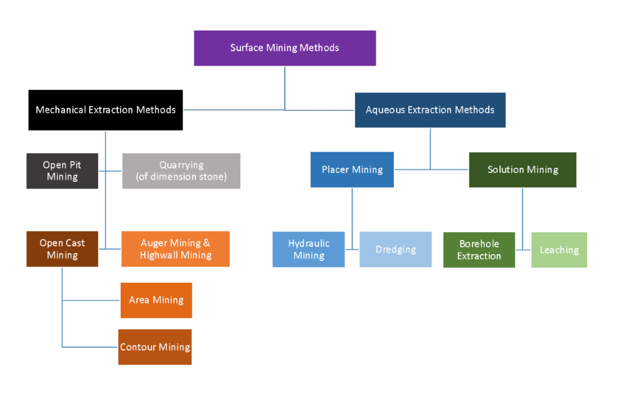Lesson 7.2: Mechanical Surface Mining Methods - Introduction & Open Pit Mining
Earlier in the course, we discussed the factors that go into the selection of a mining method, and we listed the major mining methods. Why can’t we use a single method to extract all minerals located near the surface?
Consider the following examples:
- A flat-lying bituminous coal seam of relatively uniform thickness. The coal is soft and the overburden can range from soft to moderately hard.
- A steeply pitching anthracite coal seam of relatively uniform thickness. The coal is moderately soft and the overburden can range from soft to moderately hard.
- A massive porphyry copper deposit shaped like a bowl or a giant mushroom. The orebody and surrounding rock are generally hard, i.e., strong and competent.
- A placer gold deposit, which consists of unconsolidated banks or layers of discrete grains, which are often found in rivers or streams.
Hopefully, thinking about these has triggered your memory of our previous lessons. The primary factors affecting the choice of a surface method are the spatial orientation of the orebody with respect to the surface, i.e., tabular or amorphous, and steeply dipping or flat-lying; geotechnical characteristics or the orebody and the surrounding materials, i.e., consolidated or unconsolidated, and strong or weak; and the topography, i.e., relatively flat, hilly, or mountainous. The size of the orebody and the production requirements may affect the choice of a method or the sub method, and as we discussed earlier in the semester, there are several secondary factors that could come into play. These will become more apparent as we look at the different methods.
Surface mining methods can be categorized into two broad groups based on the method of extraction:
- Mechanical Extraction Methods
- Aqueous Extraction Methods
Mechanical extraction methods employ mechanical processes in a relatively dry environment to mine minerals from the Earth’s crust. In contrast, aqueous methods involve water, or occasionally other liquids, to extract minerals.
The surface mining methods can be classified as shown here. We will discuss the mechanical extraction methods in this lesson.

Click to expand to provide more information
Surface Mining methods can be divided into two broad categories:
- Mechanical Extraction Methods, and
- Aqueous Extraction Methods.
Aqueous Extraction Methods involve water, or occasionally other liquids, to extract minerals.
Mechanical Extraction Methods, which are discussed in this module, include:
- Open Pit Mining,
- Quarrying (of dimension stone),
- Open Cast Mining, which includes Area Mining and Contour Mining, and
- Auger Mining and Highwall Mining.
OK, with this brief “memory jogger” out of the way, let’s start our discussion of mechanical extraction methods with one of the most frequently used methods, known as open pit mining.